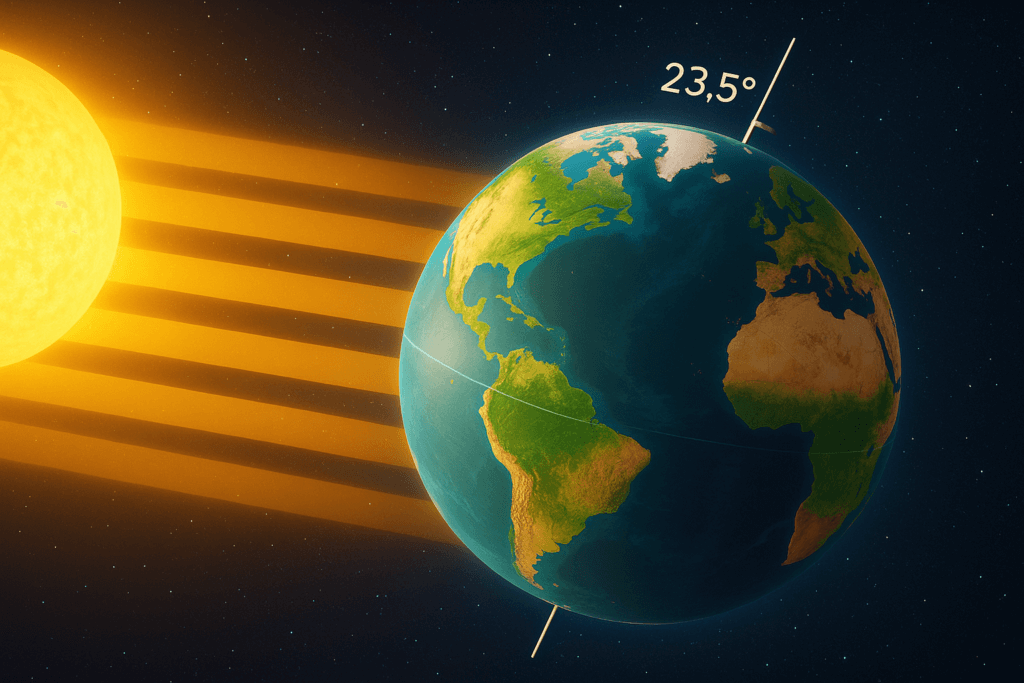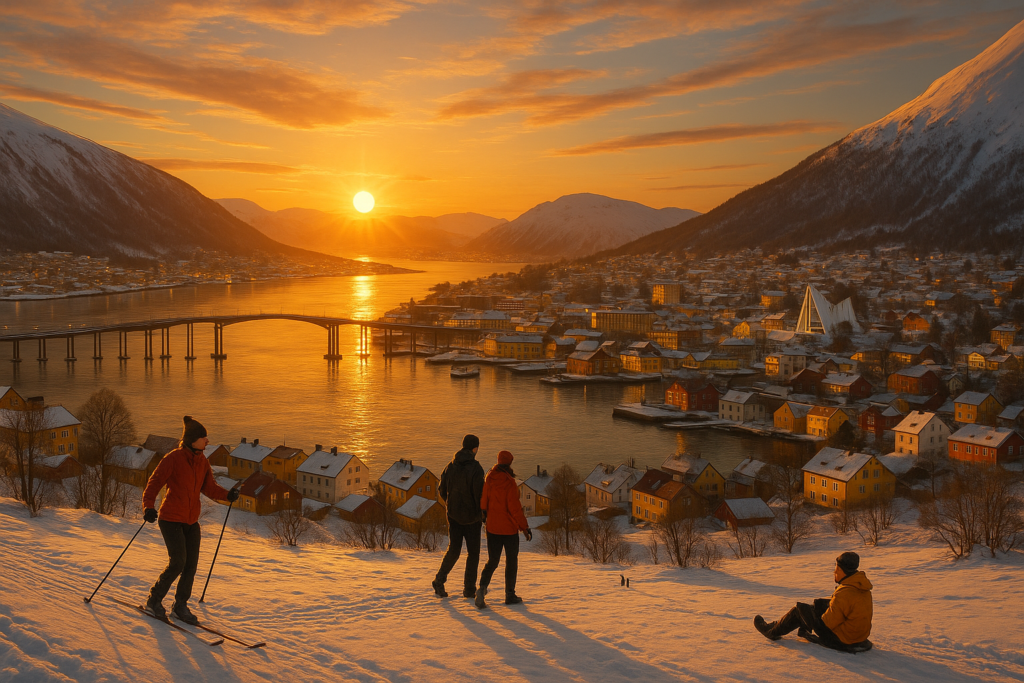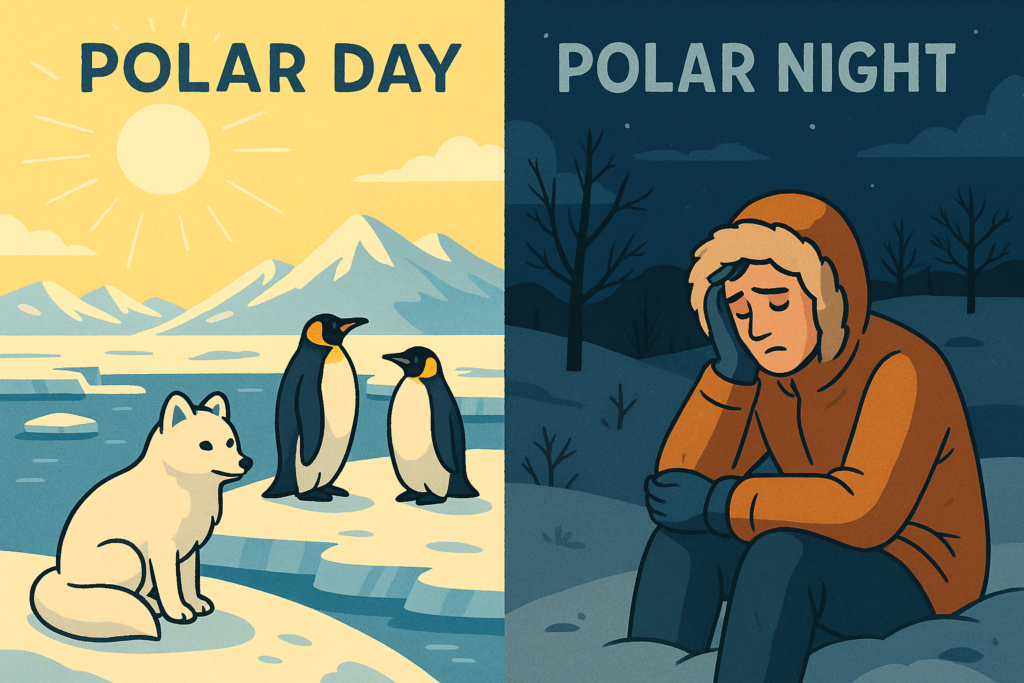Have you ever wondered why the sun doesn’t set or rise for months in certain parts of the world? This fascinating phenomenon, known as Polar Day and Polar Night, occurs in the polar regions like the Arctic and Antarctic. Due to Earth’s tilted axis, these regions experience extreme sunlight or total darkness for extended periods. In this post, we will explore how Polar Day and Polar Night affect the environment, wildlife, and human life, and uncover the science behind this incredible natural occurrence.
1. Earth’s Axis and Its Tilted Position
Earth rotates on an axis, which is an imaginary line running from the North to the South Pole. However, this axis is not perfectly upright; it’s tilted at an angle of about 23.5 degrees. This tilt is significant because it causes different parts of Earth to receive sunlight at different times and in varying intensities throughout the year. During Earth’s rotation, some regions get sunlight for longer periods, while others experience shorter days. This tilt is why the sun behaves differently in the polar regions, where some areas experience constant daylight or total darkness for extended periods.

2. What Are Polar Day and Polar Night?
In the polar regions, the sun’s behavior is categorized into two main phenomena – Polar Day and Polar Night.
- Polar Day: This is the time when the sun stays above the horizon and shines continuously for days or even months. This occurs in the polar regions during the summer months, and the sun doesn’t dip below the horizon at all during this time.
- Polar Night: In contrast, the Polar Night occurs when the sun stays completely below the horizon for an extended period, often lasting for months. During this time, the regions experience total darkness, with no sunlight whatsoever.
3. Continuous Sunshine During Polar Day
During Polar Day, the sun does not set for several months. For example, in Norway, specifically in the town of Tromsø, the sun doesn’t set from May to July. It remains above the horizon for 24 hours, providing continuous daylight. This phenomenon is fascinating because there is no clear distinction between day and night. People experience constant daylight, which can be exciting, but it also has an impact on the local lifestyle. In these regions, even at night, the sky remains lit up with the sun’s faint glow, causing beautiful changes in the sky’s colors.
Example: In Tromsø, Norway, the city experiences “midnight sun,” a phenomenon where the sun never sets for over two months, offering 24 hours of daylight.

4. The Darkness of Polar Night
On the other hand, Polar Night is a period when the sun doesn’t rise above the horizon for several months. In the Antarctic region, for instance, the sun remains below the horizon for about six months. This results in constant darkness during the winter months, typically from March to September. While the timing and duration may vary slightly between the Arctic and Antarctic regions, the result is the same: no sunlight. This extended darkness isn’t just visually striking, it also presents unique challenges for the environment and living organisms in these regions.
Example: In Antarctica, the sun doesn’t rise for about six months during the winter, and the residents experience months of continuous darkness.
Why Do Stars Twinkle? The Atmospheric Science Behind Starlight
5. Who Are Affected by These Events?
These phenomena don’t just affect the weather; they also have significant effects on the people and wildlife living in these polar regions. During Polar Day, the constant sunlight can lead to extended periods of warmth, which might seem exciting but can also cause discomfort. On the other hand, Polar Night affects the human circadian rhythm, often leading to Seasonal Affective Disorder (SAD) and other mental health challenges. These prolonged periods of sunlight and darkness can disrupt biological clocks, affecting people’s sleep cycles, mood, and overall well-being.

6. Examples of the Sun’s Behavior in Arctic and Antarctic Regions
Both the Arctic and Antarctic regions experience unique behaviors of the sun.
- Arctic Circle: Countries like Norway, Sweden, Finland, and parts of Russia experience Polar Day from May to July, when the sun remains visible throughout the day. In contrast, from November to February, these areas face Polar Night, when the sun doesn’t rise at all.
- Antarctica: Similarly, in Antarctica, the sun shines continuously during the summer months, and during the winter months, it remains completely absent from the sky for months.
7. The Impact of the Sun’s Changing Behavior in Polar Regions
The changing behavior of the sun in these regions affects various aspects of life:
- Environmental Impact: The continuous sunshine or absence of sunlight significantly impacts local temperatures, which in turn affects the natural ecosystem.
- Human Life: The absence of sunlight or its constant presence has a direct impact on mental health, leading to conditions like SAD (Seasonal Affective Disorder).
- Wildlife Behavior: Many animals in these regions have adapted to these extreme conditions, altering their feeding, mating, and survival strategies based on the availability of sunlight.
9. Conclusion
The sun’s unusual behavior in the polar regions – with Polar Day and Polar Night – is a fascinating phenomenon caused by Earth’s tilted axis. It affects not only the weather and the environment but also the lives of people and animals living in these extreme regions. Understanding the continuous sunlight and darkness experienced in these areas helps us appreciate the wonders of nature. These phenomena serve as a reminder of the intricate relationship between Earth’s rotation and its interaction with the sun.
Does the sun shine during Polar Night?
No, during Polar Night, the sun remains below the horizon, and the region stays in darkness.
Is there a sunset during Polar Day?
No, during Polar Day, the sun doesn’t set and remains visible for days or months depending on the location.
Do all polar regions experience Polar Day and Polar Night?
Yes, both Arctic and Antarctic regions experience Polar Day and Polar Night, although the specific timing and duration may vary.
